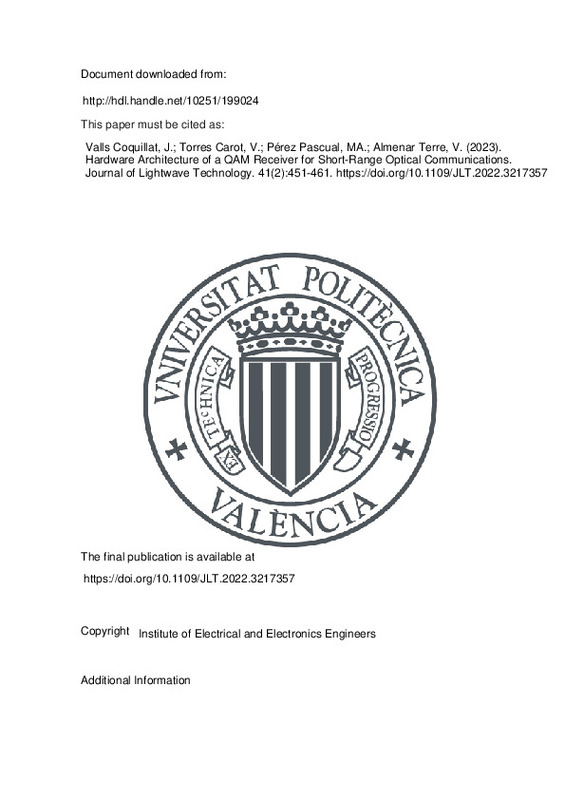JavaScript is disabled for your browser. Some features of this site may not work without it.
Buscar en RiuNet
Listar
Mi cuenta
Estadísticas
Ayuda RiuNet
Admin. UPV
Hardware Architecture of a QAM Receiver for Short-Range Optical Communications
Mostrar el registro sencillo del ítem
Ficheros en el ítem
| dc.contributor.author | Valls Coquillat, Javier
|
es_ES |
| dc.contributor.author | Torres Carot, Vicente
|
es_ES |
| dc.contributor.author | Pérez Pascual, Mª Asunción
|
es_ES |
| dc.contributor.author | Almenar Terre, Vicenç
|
es_ES |
| dc.date.accessioned | 2023-10-30T19:03:57Z | |
| dc.date.available | 2023-10-30T19:03:57Z | |
| dc.date.issued | 2023-01-15 | es_ES |
| dc.identifier.issn | 0733-8724 | es_ES |
| dc.identifier.uri | http://hdl.handle.net/10251/199024 | |
| dc.description.abstract | [EN] Short-reach optical fiber communications systems aim to achieve high throughput, in the order of tens of Gbps. The implementation of these high-speed systems requires parallel processing, which makes low-complexity designs of their subsystems a key to the successful large-scale deployment of this technology. Half-Cycle Nyquist Subcarrier Modulation (HC-SCM) was originally suggested for these systems with the goal of using as much bandwidth as possible and, therefore, achieving high communication rates. Recently, Oversampled Subcarrier Modulation (OVS-SCM) was proposed as an alternative more computational efficient than HC-SCM and also with a better spectral efficiency. This paper proposes a hardware-efficient architecture for an OVS-SCM receiver, which takes into account the inherent parallel processing of these systems. This receiver takes 16 samples in parallel from a 5 GSa/s analog-to-digital converter with a 3.2 GHz 3 dB bandwidth. Design solutions for the frame detection block, the mixer, the resampler, the fractional interpolator, the matched filter and the timing estimator are presented. Our results show that, compared to the HC-SCM receiver, this proposal reduces the computational load of the downconverter stages by 90%. FPGA implementation results are given to demonstrate that our proposal can be implemented in state-of-the-art devices. | es_ES |
| dc.description.sponsorship | This work was supported in part by MCIN/AEI/10.13039/501100011033 under Grants RTI2018-101658-B100 and PID2021-126514OB-I00, and in part by the European Union through "ERDF Away of making Europe." | es_ES |
| dc.language | Inglés | es_ES |
| dc.publisher | Institute of Electrical and Electronics Engineers | es_ES |
| dc.relation.ispartof | Journal of Lightwave Technology | es_ES |
| dc.rights | Reserva de todos los derechos | es_ES |
| dc.subject | Symbols | es_ES |
| dc.subject | Bandwidth | es_ES |
| dc.subject | Synchronization | es_ES |
| dc.subject | Optical fiber communication | es_ES |
| dc.subject | Optical receivers | es_ES |
| dc.subject | Mixers | es_ES |
| dc.subject | Proposals | es_ES |
| dc.subject | FPGA | es_ES |
| dc.subject | Hardware architecture | es_ES |
| dc.subject | Receiver | es_ES |
| dc.subject | Short-range optical links | es_ES |
| dc.subject.classification | TECNOLOGIA ELECTRONICA | es_ES |
| dc.subject.classification | TEORÍA DE LA SEÑAL Y COMUNICACIONES | es_ES |
| dc.title | Hardware Architecture of a QAM Receiver for Short-Range Optical Communications | es_ES |
| dc.type | Artículo | es_ES |
| dc.identifier.doi | 10.1109/JLT.2022.3217357 | es_ES |
| dc.relation.projectID | info:eu-repo/grantAgreement/AEI/Plan Estatal de Investigación Científica y Técnica y de Innovación 2017-2020/RTI2018-101658-B-I00/ES/REDES OPTICAS HIBRIDAS ENERGETICAMENTE EFICIENTES PARA COMUNICACIONES E ILUMINACION EN INTERIORES/ | es_ES |
| dc.relation.projectID | info:eu-repo/grantAgreement/AEI//PID2021-126514OB-I00//TECNOLOGÍAS ÓPTICAS SOSTENIBLES PARA COMUNICACIONES DE ACCESO CON ONDAS MILIMÉTRICAS Y LUZ VISIBLE EN REDES 6G/ | es_ES |
| dc.rights.accessRights | Abierto | es_ES |
| dc.contributor.affiliation | Universitat Politècnica de València. Escuela Politécnica Superior de Gandia - Escola Politècnica Superior de Gandia | es_ES |
| dc.contributor.affiliation | Universitat Politècnica de València. Escuela Técnica Superior de Ingenieros de Telecomunicación - Escola Tècnica Superior d'Enginyers de Telecomunicació | es_ES |
| dc.description.bibliographicCitation | Valls Coquillat, J.; Torres Carot, V.; Pérez Pascual, MA.; Almenar Terre, V. (2023). Hardware Architecture of a QAM Receiver for Short-Range Optical Communications. Journal of Lightwave Technology. 41(2):451-461. https://doi.org/10.1109/JLT.2022.3217357 | es_ES |
| dc.description.accrualMethod | S | es_ES |
| dc.relation.publisherversion | https://doi.org/10.1109/JLT.2022.3217357 | es_ES |
| dc.description.upvformatpinicio | 451 | es_ES |
| dc.description.upvformatpfin | 461 | es_ES |
| dc.type.version | info:eu-repo/semantics/publishedVersion | es_ES |
| dc.description.volume | 41 | es_ES |
| dc.description.issue | 2 | es_ES |
| dc.relation.pasarela | S\486204 | es_ES |
| dc.contributor.funder | AGENCIA ESTATAL DE INVESTIGACION | es_ES |
| dc.contributor.funder | European Regional Development Fund | es_ES |
| upv.costeAPC | 1331 | es_ES |







![[Cerrado]](/themes/UPV/images/candado.png)

